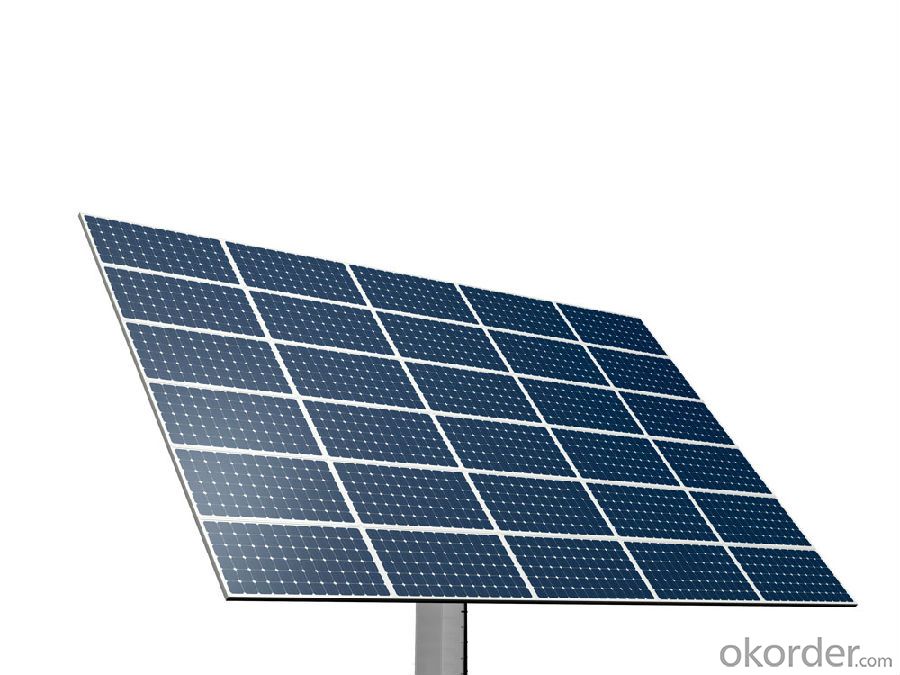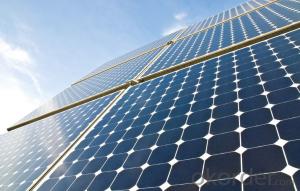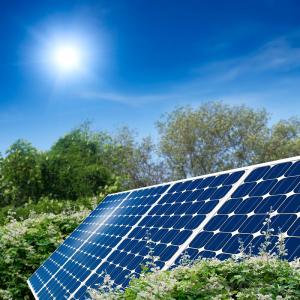Monocrystalline Silicon 255w Solar Module
- Loading Port:
- China main port
- Payment Terms:
- TT OR LC
- Min Order Qty:
- 100000 watt
- Supply Capability:
- 10000000 watt/month
OKorder Service Pledge
OKorder Financial Service
You Might Also Like
As a solar brandoriginated from America (USA) with production bases in USA, China, Taiwan andVietnam, Amerisolar is taking more competitive strategies based on its Leading Technology, High Quality, No Anti-dumping Tariff prices and worldwide Door-to-Doorlogistics services.
Quality Certificates
IEC61215, IEC61730, IEC62716, IEC61701, UL1703, ETL, JET, CE, MCS,
CEC, Israel Electric, Kemco
ISO9001:2008: Quality management system
ISO14001:2004: Environmental management system
OHSAS18001:2007: Occupational health and safety management system
Amerisolar’s photovoltaic modules are designed for large electrical power requirements. With a 30-year warranty, AS-6M30 offers high-powered, reliable
performance for both on-grid and off-grid solar projects.

FAQ:
1. How long will my inquiry get response?
Your inquiry related to our products or prices will be replied within 24 hours.
2. Can I get professional service and suggestion?
Well-trained and experienced staffs to answer all your questions in fluent English.
3. Do you accept OEM or customized design?
OEM & ODM, any your customized lightings we can help you to design and put into product.
4. What if I need specific design?
Distributorship are offered for your unique design and some our current models.
- Q:Can solar panels be used in areas with high temperatures?
- Yes, solar panels can be used in areas with high temperatures. In fact, solar panels are designed to withstand a wide range of temperatures, including high heat. While excessive heat may slightly reduce their efficiency, modern solar panels are equipped with cooling mechanisms that help maintain their performance even in hot climates.
- Q:I am thinking of buying a 3w solar panel called the nomad 3 from goal zero. I want to charge 35Wh lithum batteries. I have heard that lithium batteries are temperatmental and without a regulated current things could get ugly.I have a couple of chargers that came with the batteries. One is a 2v car charger and another is 0-240v wall charger.Goal zero sell something called a sherpa 50, which contains rechargeable batteries and an inverster and I think they suggest that I charge my batteries indirectly through the Sherpa 50, however, the sherpa 50 is expensive at $200, and seems to have a small capacity, in addition to being extra weight that i don`t want to carry.Electronics geniuses, you are my only hope.
- If you want to energy each USB ports on the identical times, It could not be possibble. Your sun panel best provides 2.24 Watts (20V * 0.2A) of energy and you ought to deliver 2.5 Watts (5V * 0.5A) to the ports. Subtracting any losses out of your regulator(s), you are going to be method over your vigor finances. You'll want extra of a sun panel or less of a load.
- Q:I am doing a school project and we need to find the cost of solar panels for our school. The problem is i don't know what size the system needs to be. Is it 000 watts or 000000 watts?Also can you find the cost of the system?Thanks
- Without them providing the amount of energy your school uses then it's impossible to know how many panels you would need. Just phrase it in the form of how much space or how many panels would be needed to create (X) amount of power. Ask the amount the school uses then go from there. Let's put it this way, with today's solar technology you would probably have to cover most of the roof of the school with solar panels and it still wouldn't be enough to run the school entirely. Never mind the cost of out-fitting a building of that size, it would take far to many years to pay off and would probably never offset the cost of electricity they are paying now considering maintenance, upkeep and replacement costs associated with these systems. If it was that easy and cost effective, they would have already done it. Make sure you squeeze that into your report somewhere. Find out how much electricity costs in your area, its on any electric bill, it should show the cost per Kw/h somewhere (If separated by peak time and non-peak time, your school would be peak time). After you get that and how much the school uses, do the math and include a graph comparison showing the cost of both. You should be able to find the costs of solar panels online somewhere. Do a side by side comparison from start up cost, upkeep and all versus using the current source. Good luck on your report.
- Q:Can solar panels be installed on a high-rise building?
- Yes, solar panels can be installed on a high-rise building. In fact, high-rise buildings are ideal candidates for solar panel installations due to their large surface areas and access to sunlight. However, certain factors such as structural considerations, building ownership, and local regulations need to be taken into account before installation.
- Q:Can solar panels be installed on a small scale?
- Yes, solar panels can be installed on a small scale. In fact, they are highly adaptable and can be installed on rooftops, balconies, or even small plots of land. This makes them a convenient and cost-effective solution for individuals or small businesses looking to generate their own renewable energy.
- Q:Are there any maintenance requirements for solar panels?
- Yes, solar panels do require some maintenance. Regular cleaning to remove dust and debris is recommended to maximize their efficiency. Additionally, inspecting the panels for any signs of damage or wear, and ensuring proper wiring and connections, are important maintenance tasks.
- Q:I read on CNN's website last year some company was creating a very cheap type of solar panel, that needs minimal maintenance and and has minimal glare from the sun. And the creator of the project said he one day wanted to cover every rooftop in the US with these solar panels. Seems like a good idea to me but I havent heared anything of it for a long time and I don't know what they are called... any help?
- The cheapest will be solar paint where you lay down some wires and paint the panel on. Solar roof tiles are also coming along but each tile has to be wired in. Currently the target is $ a watt. The efficiencies of these panels are very low but if the cost is low enough then the efficiencies won't matter. Keep in mind that even fossil fuel is solar power, just solar power captured by photosynthesis millions of years ago, and photosynthesis has a maximum theoretical efficiency of 6.6% with most plants achieving less than % efficiency so even an inefficient solar paint already outstrips our current energy sources in terms of efficiencies. The real problem is the business model. With solar energy you can sell the panels upfront but then what do you do for an income whereas with fossil fuels, you sell every kwh and bill each month.
- Q:I need to know how solar photovoltaic panels work. Anyone have a good explanation?
- Hey E Girl, photovoltiac panels are pretty simple. They start with a solid block of silicone, and shave thin layers off of them, called wafers. Once you have about 72 of them, you take half of them and dope them with boron, then the other half are doped with phosphorous. Once that's done, they take one each phosphorous and boron wafer, and glue them together with a special conductive epoxy glue, and attach a wire to each wafer. When the two glued wafers are exposed to the sun, a reaction occurs that forces free electrons from the silicone particles from one wafer onto the other, and a voltage is generated between them, about /2 volt to be exact. Once all 36 pairs are glued together, they are wired in series, connecting the phosphourous wafer from one to the boron wafer on the next, and so on. If you start with 72 wafers, you'll have 36 pairs glued together when you are done. At /2 volt each, that makes a 8 volt panel, which is used to charge a 2 volt battery. The charging source always has to have a few more volts than the battery. These 36 pairs of cells are then arranged on some kind of back board, glued down, covered with acrylic glass and mounted in a frame. There are some great websites you can go to for more info, I will list some below. Did you know that there are over 00,000 homes and businesses in the US alone that use some level of solar power to operate their electrical systems? That's good news. We actually live in one of those homes, it is powered by both the wind and sun and heated with solar and wood. I hope this answers your question, good luck, and take care, Rudydoo
- Q:Do solar panels require batteries?
- No, solar panels do not require batteries.
- Q:How do solar panels impact the electric bill?
- Solar panels can significantly reduce or even eliminate electric bills by generating electricity from the sun. By harnessing solar energy, homeowners can offset their electricity consumption with clean and renewable energy, therefore reducing their reliance on the grid and the associated costs. Additionally, excess energy produced by solar panels can be stored in batteries or fed back into the grid, allowing homeowners to earn credits or compensation for the surplus electricity they generate.
1. Manufacturer Overview |
|
|---|---|
| Location | |
| Year Established | |
| Annual Output Value | |
| Main Markets | |
| Company Certifications | |
2. Manufacturer Certificates |
|
|---|---|
| a) Certification Name | |
| Range | |
| Reference | |
| Validity Period | |
3. Manufacturer Capability |
|
|---|---|
| a)Trade Capacity | |
| Nearest Port | |
| Export Percentage | |
| No.of Employees in Trade Department | |
| Language Spoken: | |
| b)Factory Information | |
| Factory Size: | |
| No. of Production Lines | |
| Contract Manufacturing | |
| Product Price Range | |
Send your message to us
Monocrystalline Silicon 255w Solar Module
- Loading Port:
- China main port
- Payment Terms:
- TT OR LC
- Min Order Qty:
- 100000 watt
- Supply Capability:
- 10000000 watt/month
OKorder Service Pledge
OKorder Financial Service
Similar products
New products
Hot products
Related keywords






























